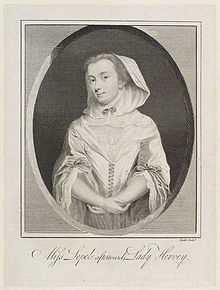Mary Hervey

Mary Hervey, Lady Hervey (née Lepell; 1700–1768) was an English courtier.
Early life
Born around 1700, Mary Lepell was the daughter of Brigadier-general Nicholas Wedig Lepell and his wife, Mary Brooke, daughter and co-heiress of John Brooke of Rendlesham, Suffolk. Her tombstone states that she was born on 26 September 1700; there is, however, some uncertainty about the date of her birth and the baptism registers state it was 16 September 1699.[1]
Her father was born in Germany, while a page of honour to Prince George of Denmark, married in 1698, and in the following year obtained an act of naturalisation. On 3 April 1705 he received a Commission to raise a new regiment of foot, and on 1 January 1710 was promoted to the rank of brigadier-general, before being appointed Supreme Commander of the British Forces in Spain, which position he held until 1712.[2]
In 1715, through family connections, she was appointed a Maid of Honour to Queen Caroline.[3] According to a letter written by the Duchess of Marlborough in December 1737, Mary was made a cornet by her father "in his regiment as soon as she was born … and she was paid many years after she was a maid of honour. She was extreme forward and pert, and my Lord Sunderland got her a pension of the late king George I, it being too ridiculous to continue her any longer an officer in the army."
Encomia
At court Mary Lepell divided the honours for wit and beauty with her friend Edith Bellenden, subsequently the wife of Colonel John Campbell, who became the fourth Duke of Argyll. Pope and Gay sang her praises. Pulteney and Chesterfield wrote a joint ballad in her honour to the tune of "Molly Mogg". Voltaire, another of her numerous admirers, addressed a copy of verses to her beginning with the lines:
Hervey, would you know the passion
You have kindled in my breast?
which are the only English verse now extant of his composition. They were subsequently transcribed and addressed to one Laura Harley, the wife of a London merchant, by one of her lovers, and formed part of the husband's evidence in his proceedings for a divorce (Churton Collins, Essay on Voltaire in England, 1886, pp. 248–9). Even Horace Walpole, who became a correspondent of hers later in life, and in 1762 dedicated to her his 'Anecdotes of Painting in England,' always spoke of her with the greatest respect and admiration (see Letters, v. 129). Her good sense and good nature won for her the esteem of the ladies as well as the flatteries of the wits.
Marriage
Her marriage with John Hervey, afterwards Lord Hervey of Ickworth, was announced to have taken place on 25 October 1720. It must, however, have occurred several months earlier, as in a letter preserved at Ickworth, and dated 20 May 1720, Lord Bristol congratulates her on her marriage, which he calls a secret. Lady Mary Wortley Montagu records, in a letter written to the Countess of Mar, in July 1721, `the ardent affection' shown to her by Mrs. Hervey and her dear spouse'.
In spite of her husband's infidelity she lived with him on very amicable terms, and was an admirable mother to a large family of troublesome children, who inherited those peculiar qualities which gave rise to the well-known saying, ascribed to Lady Mary Wortley Montagu among others, "that this world consisted of men, women, and Herveys". She appears to have been always a warm partisan of the Stuarts. Though she suffered greatly from severe attacks of the gout, she retained many of the attractions of her youth long after her husband's death.
Chesterfield, in a letter to his son dated 22 October 1750, directed him to "trust, consult, and to apply" to Lady Hervey at Paris. He speaks in the most admiring terms of her good breeding, and says that she knows more than is necessary for any woman, "for she understands Latin perfectly well, though she wisely conceals it".
Issue
By her marriage with the 2nd Baron Hervey she had eight children:
- Lady Mary Hervey, married 31 October 1745 George Fitzgerald, of Turlough
- Hon. George William Hervey, later 3rd Baron Hervey, later 2nd Earl of Bristol
- Lady Lepell Hervey (15 April 1723 – 11 May 1780), married 26 February 1742/3 Constantine John Phipps, 1st Baron Mulgrave, and had issue
- Hon. Augustus John Hervey, later 3rd Earl of Bristol
- Hon. Frederick Augustus Hervey, later 4th Earl of Bristol (and father of Lady Elizabeth Foster)
- Gen. Hon. William Hervey (born 13 May 1732), died unmarried
- Lady Amelia Caroline Nassau Hervey, died unmarried
- Lady Caroline Hervey, died unmarried
Death
She died on 2 September 1768 aged 68, and was buried at Ickworth, Suffolk. The epitaph on her tombstone was written by Horace Walpole.
Lady Hervey was a lively and intelligent letter-writer. Her letters to the Rev. Edmund Morris, formerly tutor to her sons, written between 1742 and 1768, were published in 1821. Several earlier letters of hers written to the Countess of Suffolk are in the two volumes of Lady Suffolk's `Letters,' 1824.
Two portraits of Lady Hervey are in the possession of the Marquis of Bristol at Ickworth. Another, formerly belonging to the Strawberry Hill collection, painted by Allan Ramsay, was lent by Lord Lifford to the Exhibition of National Portraits at South Kensington in 1867. An engraving from a miniature, also formerly at Strawberry Hill, is in Walpole's `Letters'.
References
Citations
Bibliography
- Kilburn, Matthew (2004). "Hervey , Mary, Lady Hervey of Ickworth (1699/1700–1768)", Oxford Dictionary of National Biography, Oxford University Press.
![]() This article incorporates text from a publication now in the public domain: "Hervey, Mary". Dictionary of National Biography. London: Smith, Elder & Co. 1885–1900.
This article incorporates text from a publication now in the public domain: "Hervey, Mary". Dictionary of National Biography. London: Smith, Elder & Co. 1885–1900.